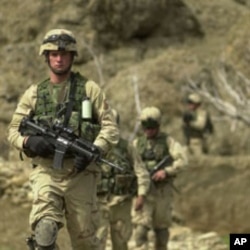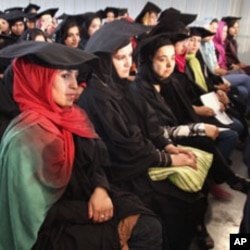Taliban rockets fired earlier this month on the U.S. embassy and NATO headquarters from across a Kabul street were a symbolic strike against a 10-year U.S.-led effort to stabilize and rebuild a nation devastated by decades of civil war, a Soviet occupation and a Taliban campaign to reshape Afghans in their own fundamentalist image.
For a decade beginning with the 9/11 terrorist attacks in the United States and Operation Enduring Freedom, the U.S. government has led a major and costly effort to offer Afghanistan a greater sense of domestic security, a new style of governance and control of its economic destiny. The Congressional Research Service reports that the combined efforts of the U.S. Department of Defense, the State Department and USAID (U.S. Agency for International Development) have cost the U.S. government $444 billion.
Afghanistan is a pioneering attempt to rebuild one of the world’s poorest and most conflicted nations. The U.S. learned some hard but invaluable lessons from its experience in Iraq. And like in Iraq, the U.S. faces a deadline on its presence in Afghanistan as well.
The United States has vowed to remove the final 100,000 U.S. troops from Afghanistan in 2014. They have three years left to make a durable state capable of growing a diversified and sustainable economy from a largely rural and traditional society whose major crop is now poppies grown for an illegal international heroin trade. Will Operation Enduring Freedom offer Afghanistan lasting political and economic freedom?
The lion’s share of money spent in Afghanistan and Iraq has gone to fighting a war and creating post-conflict security. However, war costs trumped rebuilding. The costs of domestic reconstruction were only a small piece of the total. Together, the Pentagon, USAID and its parent, the State Department, spent an estimated $50 billion on building key institutions for a once-failed state: an electoral process, an army, police force, schools, health clinics, roads, bridges and power plants. USAID spent $12 billion in funds on development.
However, recent studies now report that some of this money was wasted. “We threw so much money at Iraq and spent so much and wasted a lot,” said Chris Shays, a co-chairman of the Wartime Commission for Contracting in Iraq and Afghanistan and former U.S. Congressman from Connecticut. “So, we’re not repeating them in Afghanistan.” The Commission’s report cites expensive flaws in the way the U.S. government issues and manages contracts. The group just submitted a report to Congress identifying about $60 billion in fraud, waste and abuse – and projects that are unsustainable because Afghanistan and Iraq either cannot afford or do not want them.
|
Findings in figures: |
|
Despite claims of funds wasted or misspent, some scholars and development experts give the United States high marks for the reconstruction efforts, starting with security.
Building a functioning state in a war zone
“The Afghan army and police are becoming a pretty viable and pretty respectable institution,” said Michael O’Hanlon of the Brookings Institution. “I think, therefore, that there are the makings of a new Afghan state which has some degree of centralized control and power over its own territory.”
However, O’Hanlon hedges his assessment with several substantial caveats for Afghanistan’s future security. “Obviously, it’s a weak state. Obviously, it doesn’t control all of its territory. It’s under threat, it has a lot of corruption and other problems but it does have some of the trappings and prerequisites of a functioning nation state.”
O’Hanlon has been tracking for the past 10 years Afghanistan’s state-building process through a post-conflict lens of state-building expenditures that have been borne predominantly by the Pentagon.
Daniel Serwer of the Middle East Institute is equally concerned about the current vulnerability of the Afghan state. Serwer advocates a larger role for civilian actors working through the State Department and other U.S. federal agencies. “We really didn’t try hard in Afghanistan.” He said development efforts were given short shrift. “For years after the war, there was very little assistance.”
The Commission’s final report and findings from others such as the International Conflict Group (ICG) come at a time when Congress begins an annual examination of funding amounts for the stabilization and development both in Iraq and Afghanistan.
The recently retired U.S Secretary of Defense, Robert Gates, went on record five years ago arguing, surprisingly to some, that the State Department doesn’t get enough attention when Congress funds such operations. He illustrated the imbalance of funding by telling his audience he could put the entire U.S. Foreign Service on one battleship. He put the number at 6,600 Foreign Service officers.
“One of the most important lessons of the wars in Iraq and Afghanistan,” said Gates, “is that military success is not sufficient to win: economic development, institution building and the rule of law, promoting internal reconciliation, good governance, providing basic services to the people are essential to success in state building.”
An ICG report calls on the U.S. government to reduce military involvement in humanitarian, development and reconstruction assistance and to improve coordination between civilian and military actors. That point is echoed by others who see advantages in shifting more funds from military to civilian contractors and in some cases, from the Defense to the State Department.
Military as major player
James Carafano of the Heritage Foundation holds that in conflict nations, the military must take the lead. “The right model is when you have a conflict environment and you’re trying to help get something established, the military guys need to be in charge because the overwhelming requirement is security,” said Carafano. “Once you’re out of the conflict stage, it doesn’t matter who’s in charge.”
“There’s no question but that a deployed soldier in Afghanistan who costs over a million dollars a year is far more expensive than civilians,” said Daniel Serwer, the Middle East Institute scholar. Serwer believes that sending in civilians “is not just cheaper but better.” But adds that “This requires a real build-up of the State Department and USAID capacity that we haven’t seen.”
“The United States has relied on its military as a main instrument of its own state building and of its foreign policy for a very long time,” Serwer said. “I think we’re at the point where the extra dollars spent on the military are not as productive as extra dollars spent on the civilian instruments of projecting power.”
The ICG report also recommends the U.S. government shift from their quick-impact military or civilian stabilization programs to partner with Afghanistan’s own National Solidarity Program that promotes Afghan-led community development, places management responsibilities in the hands of more than 20,000 committees that are implementing more that 50,000 projects. That’s exactly what six non-government organizations have been doing with funding from the Gates Foundation, the European Commission, the World Bank and the governments of the Netherlands, Japan and Norway, as well as from USAID.
Experts agree that, in the end, it does not matter which agency takes the lead in post-conflict countries, but how well any manager of U.S. foreign assistance can choose and supervise projects and its contractors. At least, the Wartime Commission holds that view.
“We went into Iraq and Afghanistan unprepared to use contractors, and the military has told us they can’t go to war without contractors,” said Shays, the wartime commission’s co-chair. He was surprised to learn in the committee’s first investigations that at times in the last 10 years, U.S. contractors outnumbered U.S. troops.
‘They are re-building their own country with our support’
The Commission’s report highlights some of troubles the International Conflict Group recently addressed in Afghanistan. Aid disbursed since 2001 “has largely failed to fulfill the international community’s pledges to rebuild Afghanistan,” according to the ICG report. “Poor planning and oversight have affected projects’ effectiveness and sustainability, with local authorities lacking the means to keep projects running, layers of subcontractors reducing the amounts that reach the ground, and aid delivery further undermined by corruption in Kabul and bribes paid to insurgent groups to ensure security for development projects.”
Representatives from several leading non-governmental organizations testified in April at the Wartime Commission hearings in Washington, D.C., that not-for-profits can do a better job in the final three years in Afghanistan and Iraq. Speakers for Mercy Corps, Catholic Relief Services, Save the Children and the International Rescue Committee (IRC) argued that their development model is successful because it is based on experience in dozens of other conflicted countries over more than 20 years. They rely heavily on local communities to propose, implement and monitor projects of their own selection, such as schools, clinics, roads and bridges.
“We take a very low-cost approach, we have a small footprint, most of our staff overseas are the citizens of that nations,” said Anne Richard of the IRC. She said her organization has 400 employees in Afghanistan and 98 percent of them are Afghans. “They are re-building their own country with our support and it can be a tremendously successful enterprise.”
IRC first began working with Afghan refugees in Pakistan many years ago. In Afghanistan, they have partnered with other NGOs in supporting the growth of committee support for schools: teaching parents the value of an education, providing teacher education and getting girls into the classroom. They have partnered with several NGOs investing in development efforts through the National Solidarity Program, whose work had been endorsed by the ICG report.
“It’s true that your NGOs, like Save and Mercy Corps, and others have been in-country and know the culture and depend on the indigenous people to do the work,” Shays told VOA after the hearings.
Shays also said the committee has concerns about how USAID and the NGOs, which do the work in the field, perform due diligence in monitoring the projects. The Commission believes weaknesses in contracting occur in both agencies.
Going to war with contractors
Shays suggested a corollary to the infamous remark by former Secretary of Defense Donald Rumsfeld to a U.S. National Guard unit in Kuwait, “You go to war with the army you have.”
“If you’ve got to go to war with the army you’ve got,” Shays adds, “you’ve also got to go to war with the contractors you’ve got. And you are going to be a little more lenient for the first year or two,” Shays said. “After a few years you shouldn’t be doing the same wasteful things.
“In the first year or two you cut yourself a little slack. But we have been wasting money continually. So we need many reforms and it will take years, but it will save literally billions and billions of dollars," added Shays.















